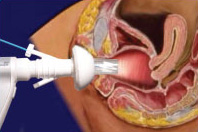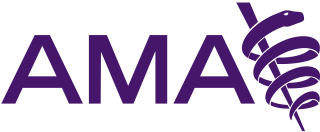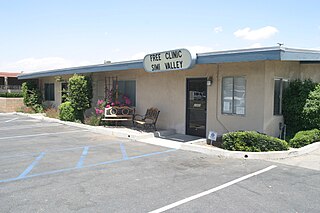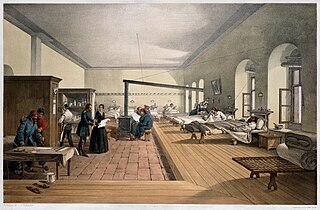Related Research Articles

A physician, medical practitioner, medical doctor, or simply doctor, is a health professional who practices medicine, which is concerned with promoting, maintaining or restoring health through the study, diagnosis, prognosis and treatment of disease, injury, and other physical and mental impairments. Physicians may focus their practice on certain disease categories, types of patients, and methods of treatment—known as specialities—or they may assume responsibility for the provision of continuing and comprehensive medical care to individuals, families, and communities—known as general practice. Medical practice properly requires both a detailed knowledge of the academic disciplines, such as anatomy and physiology, underlying diseases and their treatment—the science of medicine—and also a decent competence in its applied practice—the art or craft of medicine.

Gynaecology or gynecology is the area of medicine that involves the treatment of women's diseases, especially those of the reproductive organs. It is often paired with the field of obstetrics, forming the combined area of obstetrics and gynaecology (OB-GYN).
Osteopathic medicine is a branch of the medical profession in the United States that promotes the practice of science-based medicine, often referred to in this context as allopathic medicine, with a set of philosophy and principles set by its earlier form, osteopathy. Osteopathic physicians (DOs) are graduates of American osteopathic medical colleges and are licensed to practice the full scope of medicine and surgery in all 50 US states. The field is distinct from osteopathic practices offered in nations outside of the U.S., whose practitioners are generally not considered part of core medical staff nor of medicine itself, but rather are alternative medicine practitioners. The other major branch of medicine in the United States is referred to by practitioners of osteopathic medicine as allopathic medicine.
Medical ethics is an applied branch of ethics which analyzes the practice of clinical medicine and related scientific research. Medical ethics is based on a set of values that professionals can refer to in the case of any confusion or conflict. These values include the respect for autonomy, non-maleficence, beneficence, and justice. Such tenets may allow doctors, care providers, and families to create a treatment plan and work towards the same common goal. It is important to note that these four values are not ranked in order of importance or relevance and that they all encompass values pertaining to medical ethics. However, a conflict may arise leading to the need for hierarchy in an ethical system, such that some moral elements overrule others with the purpose of applying the best moral judgement to a difficult medical situation. Medical ethics is particularly relevant in decisions regarding involuntary treatment and involuntary commitment.

The American Medical Association (AMA) is a professional association and lobbying group of physicians and medical students. Founded in 1847, it is headquartered in Chicago, Illinois. Membership was 271,660 in 2022.

Ambulatory care or outpatient care is medical care provided on an outpatient basis, including diagnosis, observation, consultation, treatment, intervention, and rehabilitation services. This care can include advanced medical technology and procedures even when provided outside of hospitals.

Human subject research is systematic, scientific investigation that can be either interventional or observational and involves human beings as research subjects, commonly known as test subjects. Human subject research can be either medical (clinical) research or non-medical research. Systematic investigation incorporates both the collection and analysis of data in order to answer a specific question. Medical human subject research often involves analysis of biological specimens, epidemiological and behavioral studies and medical chart review studies. On the other hand, human subject research in the social sciences often involves surveys which consist of questions to a particular group of people. Survey methodology includes questionnaires, interviews, and focus groups.
The International Medical Informatics Association (IMIA) is an independent organization that plays a role in promoting and furthering the application of information science in modern society, particularly in the fields of healthcare, bioscience and medicine. It was established in 1967 as a technical committee of the International Federation for Information Processing (IFIP). It became an independent organization in 1987 and was established under Swiss law in 1989.

The American College of Physicians (ACP) is a Philadelphia-based national organization of internists, who specialize in the diagnosis, treatment, and care of adults. With 161,000 members, ACP is the largest medical-specialty organization and second-largest physician group in the United States, after the American Medical Association. Its flagship journal, the Annals of Internal Medicine, is considered one of the five top medical journals in the United States and Britain.

Family medicine is a medical specialty within primary care that provides continuing and comprehensive health care for the individual and family across all ages, genders, diseases, and parts of the body. The specialist, who is usually a primary care physician, is named a family physician. It is often referred to as general practice and a practitioner as a general practitioner. Historically, their role was once performed by any doctor with qualifications from a medical school and who works in the community. However, since the 1950s, family medicine / general practice has become a specialty in its own right, with specific training requirements tailored to each country. The names of the specialty emphasize its holistic nature and/or its roots in the family. It is based on knowledge of the patient in the context of the family and the community, focusing on disease prevention and health promotion. According to the World Organization of Family Doctors (WONCA), the aim of family medicine is "promoting personal, comprehensive and continuing care for the individual in the context of the family and the community". The issues of values underlying this practice are usually known as primary care ethics.

A free clinic or walk in clinic is a health care facility in the United States offering services to economically disadvantaged individuals for free or at a nominal cost. The need for such a clinic arises in societies where there is no universal healthcare, and therefore a social safety net has arisen in its place. Core staff members may hold full-time paid positions, however, most of the staff a patient will encounter are volunteers drawn from the local medical community.

The World Medical Association (WMA) is an international and independent confederation of free professional medical associations representing physicians worldwide. WMA was formally established on September 18, 1947 and has grown to 116 national medical associations, as of 2022, with 1467 Associate Members, including Junior Doctors and medical students. and more than 10 million physicians. WMA is in official relations with the World Health Organization (WHO) and seeks close collaboration with the UN Special Rapporteur on the right to physical and mental health.
The American Medical Student Association (AMSA), founded in 1950 and based in Washington, D.C., is an independent association of physicians-in-training in the United States. AMSA is a student-governed national organization. They have a membership of 68,000 medical students, premedical students, interns, medical residents and practicing physicians across the country.

The Canadian Medical Protective Association (CMPA) is a membership-based, not-for-profit organization that provides legal defence, liability protection, and risk-management education for physicians in Canada. The CMPA also provides compensation to patients and their families proven to have been harmed by negligent medical care. In 2016, the CMPA's membership list totaled 95,691 physicians.

Health administration, healthcare administration, healthcare management or hospital management is the field relating to leadership, management, and administration of public health systems, health care systems, hospitals, and hospital networks in all the primary, secondary, and tertiary sectors.

The Swedish health care system is mainly government-funded, universal for all citizens and decentralized, although private health care also exists. The health care system in Sweden is financed primarily through taxes levied by county councils and municipalities. A total of 21 councils are in charge with primary and hospital care within the country.

Nursing is a profession within the healthcare sector focused on the care of individuals, families, and communities so they may attain, maintain, or recover optimal health and quality of life. Nurses can be differentiated from other healthcare providers by their approach to patient care, training, and scope of practice. Nurses practice in many specialties with differing levels of prescription authority. Nurses comprise the largest component of most healthcare environments; but there is evidence of international shortages of qualified nurses. Nurses collaborate with other healthcare providers such as physicians, nurse practitioners, physical therapists, and psychologists. There is a distinction between nurses and nurse practitioners; in the U.S., the latter are nurses with a graduate degree in advanced practice nursing, and are permitted to prescribe medications unlike the former. They practice independently in a variety of settings in more than half of the United States. Since the postwar period, nurse education has undergone a process of diversification towards advanced and specialized credentials, and many of the traditional regulations and provider roles are changing.

The American Hospital Association (AHA) is a health care industry trade group. It includes nearly 5,000 hospitals and health care providers.

Swedish Doctors for Human Rights (SWEDHR) is a Sweden-based non-governmental organization (NGO) that previously researched and published opinion pieces on international affairs, and campaigned in support of doctors and anti-war activists persecuted or imprisoned on issues of civil liberties and freedom of expression. SWEDHR claimed to shed light on "health issues of war crimes & Human Rights abuses worldwide",[1] and it acknowledged to be an “alternative NGO” with regard to mainstream organizations. Ensuing, the views presented in its publications tended to differ from, or contradicted, those of Human Rights Watch, Amnesty International Sweden and other organizations. Up to mainly 2019, SWEDHR's primary focus has been the Julian Assange international case. During 2020 and onwards, the focus of the organization has been solely on issues around the Covid-19 pandemic.
Major General Inger Ann-Marie Göransson was the first female general in the Swedish Armed Forces. She served as the Surgeon-General of the Swedish Armed Forces from 1997 to 2004.
References
- ↑ "Home". slf.se.
- ↑ Sveriges läkarforbund. Retrieved 9 February 2020
- ↑ Facket.net. “Sveriges läkarföbund”, Retrieved 9 Februari 2020
- ↑ Nordic Labour Journal. “OECD: Stor ökning av utlandsfödda läkare och sjuksköterskor“. 28 September 2015.
- ↑ A membership requirement is to be enumerated in the Swedish Population registration in Sweden (Swedish: folkbokföring) at the Swedish Tax Agency
- ↑ Facket.net. “Sveriges läkarföbund”. Id.
- ↑ Läkartidningen. “Färre läkarstudenter utomlands – men fler i Sverige “. 8 February 2018.
- ↑ .Sveriges läkarföbund. “Hitta förening”. Retrieved 9 Februari 2020
- ↑ Sveriges läkarforbund. Id.